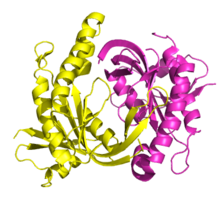Soluble guanylate cyclase
| Guanylate cyclase | |||||||||
|---|---|---|---|---|---|---|---|---|---|

|
|||||||||
| Identifiers | |||||||||
| EC number | 4.6.1.2 | ||||||||
| CAS number | 9054-75-5 | ||||||||
| Alt. names | Guanyl cyclase, Guanylyl cyclase | ||||||||
| Databases | |||||||||
| IntEnz | IntEnz view | ||||||||
| BRENDA | BRENDA entry | ||||||||
| ExPASy | NiceZyme view | ||||||||
| KEGG | KEGG entry | ||||||||
| MetaCyc | metabolic pathway | ||||||||
| PRIAM | profile | ||||||||
| PDB structures | RCSB PDB PDBe PDBsum | ||||||||
| Gene Ontology | AmiGO / EGO | ||||||||
|
|||||||||
| Search | |
|---|---|
| PMC | articles |
| PubMed | articles |
| NCBI | proteins |
Soluble guanylyl cyclase (sGC) is the only known receptor for nitric oxide, NO. It is soluble, i.e. completely intracellular. Most notably, this enzyme is involved in vasodilation. In humans, it is encoded by the genes GUCY1A2, GUCY1A3, GUCY1B2 and GUCY1B3.
It is classified under EC number 4.6.1.2.
sGC is a heterodimer composed of one alpha (1, 2) and one heme-binding beta (1, 2) subunits. Each subunit consists of four domains: an N-terminal HNOX domain, a PAS-like domain, a coiled-coil domain, and a C-terminal catalytic domain. The mammalian enzyme contains one heme per dimer, with a proximal histidine ligand located in the HNOX domain of the beta 1 subunit. In its Fe(II) form, this heme moiety is the target of nitric oxide, which is synthesized by endothelial cells following appropriate stimulation. Binding of nitric oxide to the heme results in activation of the C-terminal catalytic domain, which produces cGMP from GTP.
The HNOX (Heme Nitric oxide/OXygen binding) domain of the beta subunit of sGC contains the prosthetic heme group, and is part of a family of related sensor proteins found throughout a wide range of organisms. The HNOX domain uses the bound heme to sense gaseous ligands such as nitric oxide, oxygen, and/or possibly carbon monoxide. While the HNOX domain of sGC has no available structure, several bacterial HNOX domains have been crystallized (pdb codes 1U55, 1XBN, 2O09 and others).
sGC also contains a PAS type regulatory domain. Named after the first three proteins in which it was found (Period clock protein, ARNT protein, and Single minded protein) the PAS domain is a sensor domain that has been found in a large variety of proteins, and can work in conjunction with a variety of prosthetic groups as a sensor for a variety of conditions, including light, oxidative stress, or diatomic gases. In the case of sGC, the PAS domain mediates heterodimer formation and may play a role in signal propagation from the HNOX domain to the catalytic guanylate cyclase domain. While the PAS domain of sGC has no available structure, the PAS domain of a protein with high sequence homology to sGC has been crystallized (pdb code 2P04).
The PAS domain of sGC is followed by an extended coiled-coil region, which contains a segment called a Signaling helix, which is found in a variety of signaling proteins. The crystal structure of the coiled-coil region of the sGC beta subunit has been determined (pdb code 3HLS).
...
Wikipedia
